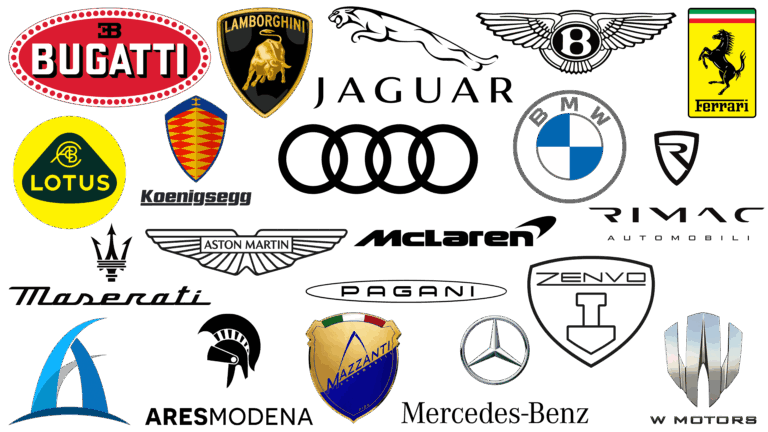Top Car Stereo Brands: Your Ultimate Guide to Audio Excellence on the Road
Top Car Stereo Brands: Your Ultimate Guide to Audio Excellence on the Road cars.truckstrend.com
The open road, a favorite playlist, and the perfect sound – for many, this combination is the essence of driving pleasure. A car’s stock stereo system, while functional, often falls short of delivering the immersive, high-fidelity audio experience that music lovers crave. This is where investing in a top-tier car stereo brand comes into play. Far more than just a radio, modern car stereos are sophisticated multimedia hubs, offering crystal-clear sound, seamless connectivity, and intuitive control, transforming your vehicle into a personal concert hall or a mobile command center.
This comprehensive guide will delve into the world of car stereo brands, exploring what sets the best apart, how to choose the right system for your needs, and spotlighting the leading manufacturers known for their innovation, sound quality, and reliability. Whether you’re an audiophile, a tech enthusiast, or simply someone who wants to enjoy their daily commute more, understanding the top car stereo brands is your first step towards elevating your in-car audio experience.
Top Car Stereo Brands: Your Ultimate Guide to Audio Excellence on the Road
The Heart of Your Ride: Understanding Car Stereos
At its core, a car stereo, often referred to as a "head unit" or "source unit," is the central control panel for your vehicle’s audio system. It’s where you select your music source (radio, CD, USB, Bluetooth, streaming apps), control volume, and often manage navigation, phone calls, and vehicle settings.
Modern car stereo systems comprise several key components working in harmony:
- Head Unit (Source Unit): The brain of the operation, containing the tuner, pre-amplifier, and often a basic amplifier.
- Amplifier: Boosts the low-level audio signals from the head unit to a powerful output capable of driving speakers. While many head units have built-in amplifiers, external amps provide significantly more power and cleaner sound.
- Speakers: Convert electrical signals into sound waves. These come in various types (component, coaxial, subwoofers) and sizes, designed for different frequency ranges.
- Subwoofer: A specialized speaker designed to reproduce low-frequency sounds (bass) with power and depth.

The evolution of car stereos has been remarkable. From basic AM/FM radios and cassette players, we’ve transitioned to CD players, then to digital media receivers, and now to advanced multimedia units featuring large touchscreens, smartphone integration (Apple CarPlay, Android Auto), GPS navigation, and sophisticated digital sound processing (DSP).
Why Invest in a Top Car Stereo Brand?
Opting for a reputable car stereo brand over a generic alternative offers a multitude of benefits that extend beyond mere sound reproduction:
- Superior Sound Quality: Top brands invest heavily in research and development, utilizing high-quality components, advanced audio processing technologies (like digital-to-analog converters – DACs, and DSPs), and robust internal amplifiers to deliver cleaner, more powerful, and more accurate sound. You’ll experience richer bass, clearer highs, and a more defined soundstage.
- Advanced Features & Connectivity: Leading brands are at the forefront of automotive technology. They offer seamless integration with smartphones via Apple CarPlay and Android Auto, advanced Bluetooth connectivity, high-resolution audio support, multiple USB inputs, built-in navigation, and customizable equalizer settings that are often absent in stock units.
- Durability and Reliability: Products from top brands are built to last. They undergo rigorous testing to withstand the harsh automotive environment (vibrations, temperature extremes, dust), ensuring consistent performance and longevity. This translates to fewer headaches and a better return on your investment.
- Enhanced User Experience: Premium brands focus on intuitive interfaces, responsive touchscreens, and ergonomic controls. This makes navigating features, adjusting settings, and interacting with your system safer and more enjoyable while driving.
- Integration and Compatibility: Reputable brands often offer a wider range of accessories and seamless integration with other aftermarket components like amplifiers, speakers, and subwoofers, allowing for a fully customized and optimized audio system.
- Aesthetics and Design: Many top car stereos feature sleek designs, customizable lighting, and high-resolution displays that can significantly upgrade your vehicle’s interior aesthetics.
Choosing Your Perfect Sound System: Key Considerations
Selecting the ideal car stereo involves more than just picking a brand. Here’s what you need to consider:
- Budget: Car stereos range from a couple of hundred dollars to well over a thousand for premium multimedia units. Define your budget early, but remember that value often comes with quality.
- Vehicle Compatibility:
- DIN Sizes: Most cars accommodate either a single-DIN (7 x 2 inches) or double-DIN (7 x 4 inches) head unit. Check your vehicle’s dash opening.
- Wiring Harness & Dash Kit: You’ll almost certainly need an aftermarket wiring harness and a dash kit to properly install a new head unit and retain factory features.
- Steering Wheel Controls: Many modern cars have audio controls on the steering wheel. You’ll need an interface module to retain these with an aftermarket stereo.
- Desired Features:
- Smartphone Integration: Apple CarPlay and Android Auto are highly sought-after for their seamless navigation, messaging, and music streaming.
- Bluetooth: Essential for hands-free calling and wireless audio streaming.
- Navigation: Built-in GPS is convenient, though many prefer using smartphone apps via CarPlay/Android Auto.
- Display: Touchscreen size, resolution, and responsiveness are crucial for multimedia units.
- Audio Customization: Look for features like a graphic equalizer (EQ), time alignment, and crossover settings for fine-tuning sound.
- High-Resolution Audio: For audiophiles, support for FLAC, WAV, and other lossless formats is a must.
- Camera Inputs: For backup cameras or front cameras.
- Sound Preference: Are you looking for crystal-clear highs, punchy mids, or earth-shattering bass? Different brands and components excel in different areas.
- Installation Complexity: While some basic installations are DIY-friendly, integrating advanced features, amplifiers, and subwoofers often requires professional expertise.
Spotlight on Excellence: Top Car Stereo Brands
When it comes to innovation, sound quality, and reliability, several brands consistently stand out in the car audio industry. Here are some of the most highly regarded:
1. Pioneer
- Legacy & Focus: A true pioneer (pun intended) in car audio, Pioneer has been a dominant force for decades. They are known for their innovation, wide range of products, and user-friendly interfaces.
- Strengths: Pioneer offers a comprehensive lineup from budget-friendly digital media receivers to high-end multimedia navigation systems. They excel in incorporating the latest connectivity features like wireless Apple CarPlay and Android Auto. Their sound processing is generally excellent, offering detailed and dynamic audio. They also have a strong presence in amplifiers and speakers.
- Target Audience: Broad appeal, from casual listeners seeking an upgrade to tech-savvy users who want all the latest features.
2. Kenwood
- Legacy & Focus: Another long-standing giant in consumer electronics, Kenwood is renowned for robust features, excellent multimedia capabilities, and often strong value for money.
- Strengths: Kenwood’s head units are frequently praised for their comprehensive navigation systems (often Garmin-powered), excellent sound quality with extensive tuning options, and durable build. They are particularly strong in multimedia receivers that cater to users who demand seamless smartphone integration and a large, responsive display.
- Target Audience: Users who prioritize a feature-rich experience, especially navigation and multimedia, without necessarily breaking the bank.
3. Alpine
- Legacy & Focus: Alpine has a reputation for premium sound quality, precision engineering, and innovative car-specific solutions. They often cater to audiophiles and those seeking a more refined audio experience.
- Strengths: Alpine units are known for their superior audio components, sophisticated sound tuning capabilities (including advanced DSPs), and large, high-resolution displays. They frequently offer vehicle-specific solutions (e.g., "Restyle" systems) that seamlessly integrate with the car’s interior and electronics. Their amplifiers and speakers are also highly regarded.
- Target Audience: Audiophiles, enthusiasts looking for the best possible sound, and owners of specific vehicles who want a factory-like integrated upgrade.
4. Sony
- Legacy & Focus: A global electronics powerhouse, Sony brings its extensive expertise in audio and visual technology to the car stereo market. They are known for sleek designs, good sound quality, and integration with their broader ecosystem.
- Strengths: Sony car stereos often feature minimalist, modern designs with crisp displays and intuitive interfaces. They offer solid sound performance, good connectivity options (including high-resolution audio support), and are often competitively priced, making them an attractive option for those looking for a balanced blend of features and value.
- Target Audience: Consumers who value brand recognition, sleek aesthetics, reliable performance, and good overall value.
5. JVC
- Legacy & Focus: Part of the JVCKENWOOD corporation, JVC has a long history in consumer electronics. They offer a range of car audio products known for reliability and good performance, often at a more accessible price point.
- Strengths: JVC provides solid, dependable head units with essential features like Bluetooth, USB, and smartphone integration. They are a great choice for those looking for a significant upgrade from their factory system without overspending. Their units offer good sound customization options for their price range.
- Target Audience: Budget-conscious buyers, those new to aftermarket car audio, or anyone seeking reliable performance without needing the absolute latest premium features.
Optimizing Your Car Audio Experience: Tips & Practical Advice
Even the best head unit won’t sound its best without proper setup.
- Professional Installation vs. DIY: While basic head unit installation can be a DIY project for the mechanically inclined, complex systems involving amplifiers, multiple speakers, and advanced wiring are best left to professional installers. They ensure proper wiring, safety, and optimal performance.
- Matching Components: A powerful head unit paired with weak speakers will still sound poor. Ensure your amplifier and speakers are appropriately matched to your head unit’s output and your desired sound.
- Sound Deadening: Applying sound deadening material to your car doors, trunk, and floor can drastically improve sound quality by reducing road noise and preventing speaker vibrations from distorting the sound.
- DSP Tuning: If your head unit has a Digital Sound Processor (DSP), learn to use it or have a professional tune it. Features like time alignment, equalization, and crossovers can dramatically improve the soundstage and clarity.
- Proper Power Wiring: For external amplifiers, ensure you use appropriately gauged power wires directly from the car battery to prevent voltage drops and ensure consistent power delivery.
- Regular Maintenance: Keep your unit’s screen clean, ensure software is updated (if applicable), and avoid extreme temperature fluctuations if possible.
Navigating Challenges and Finding Solutions
Upgrading your car stereo can come with a few hurdles:
- Challenge: Compatibility Issues. Modern cars have complex electrical systems.
- Solution: Always verify compatibility with your vehicle using online tools or consulting a professional installer. Invest in the correct wiring harnesses and dash kits.
- Challenge: Installation Complexities. Integrating steering wheel controls, factory cameras, or advanced systems can be tricky.
- Solution: Don’t hesitate to seek professional installation. It ensures safety, functionality, and optimal performance, often saving you time and frustration in the long run.
- Challenge: Budget Constraints. Top-tier systems can be expensive.
- Solution: Consider a phased upgrade. Start with a good head unit, then add an amplifier, and finally upgrade speakers or add a subwoofer as your budget allows. Look for sales and bundle deals.
- Challenge: Learning Curve for Advanced Features. Modern units are packed with features that can be overwhelming.
- Solution: Read the manual! Many brands offer online tutorials. Spend time exploring the settings when parked to become familiar with all the functionalities.
Approximate Price Guide for Top Car Stereo Brands
It’s important to note that prices for car stereos vary widely based on specific models, features, screen size, and retailer. The table below provides a general approximate price range for typical aftermarket head units (digital media receivers and multimedia units) from these brands in USD. These do not include installation costs or additional components like amplifiers or speakers.
| Brand | Typical Product Focus (Head Units) | Approximate Price Range (USD) | Key Features/Notes |
|---|---|---|---|
| Pioneer | Digital Media Receivers, Multimedia Receivers, Navigation Systems | $150 – $1200+ | Wide range from basic units to advanced systems with wireless CarPlay/Android Auto, high-res audio, extensive sound tuning. Excellent overall performance and feature set. |
| Kenwood | Multimedia Receivers, Navigation Systems, Digital Media Receivers | $180 – $1100+ | Strong emphasis on multimedia features, often with Garmin navigation, excellent display quality, and robust sound customization. Good value for feature-rich units. |
| Alpine | Premium Multimedia Receivers, Vehicle-Specific "Restyle" Systems | $300 – $1500+ | Known for superior sound quality, advanced DSPs, large high-resolution screens, and often vehicle-specific solutions for seamless integration. Higher price point reflects premium components and audio performance. |
| Sony | Digital Media Receivers, Multimedia Receivers | $100 – $800+ | Sleek designs, good sound quality, and reliable performance. Often offer good value with essential features and competitive pricing. Good integration with other Sony products. |
| JVC | Digital Media Receivers, Multimedia Receivers | $80 – $600+ | Reliable and feature-rich options at more accessible price points. A great choice for those looking for a solid upgrade without needing the most cutting-edge features or premium audio. |
| Others | (e.g., Clarion, Blaupunkt) | $80 – $500+ | While these brands have historical significance, their current market presence or product lines in the general car stereo market might be more niche or specialized (e.g., marine audio for Clarion, classic car audio for Blaupunkt), or they may focus more on specific components like amplifiers or speakers. |
Disclaimer: Prices are approximate and subject to change based on retailer, promotions, model year, and specific features. Always check current market prices before making a purchase.
Frequently Asked Questions (FAQ)
Q1: What’s the difference between single DIN and double DIN?
A1: These refer to the standard sizes of car stereo openings in dashboards. A single DIN unit is 7 inches wide by 2 inches high, while a double DIN unit is 7 inches wide by 4 inches high. Double DIN units often accommodate larger touchscreens.
Q2: Do I need an amplifier with an aftermarket head unit?
A2: Not necessarily. Most aftermarket head units have a built-in amplifier that provides more power than a factory stereo. However, for truly high-fidelity sound, more power, and better clarity, an external amplifier is highly recommended, especially if you plan to upgrade your speakers or add a subwoofer.
Q3: Can I install a car stereo myself?
A3: If you have basic DIY skills, the right tools, and a good wiring harness/dash kit, you can often install a basic single or double DIN head unit. However, complex installations involving steering wheel control retention, factory camera integration, or external amplifiers are best left to professional installers to avoid damage and ensure proper functionality.
Q4: What are Apple CarPlay and Android Auto?
A4: These are smartphone integration platforms that allow you to safely use select apps (navigation, music, messaging, phone calls) from your iPhone or Android phone directly on your car stereo’s screen. They mirror a simplified, car-friendly version of your phone’s interface.
Q5: Are more expensive car stereos always better?
A5: Generally, higher-priced stereos from reputable brands offer superior sound quality, more advanced features, better build quality, and a more refined user experience. However, "better" is subjective. The "best" stereo is the one that meets your specific needs, budget, and desired features. A mid-range unit might be perfectly sufficient for many users.
Q6: How long do car stereos typically last?
A6: A quality aftermarket car stereo from a reputable brand can last anywhere from 5 to 10 years or even longer, depending on usage, care, and the specific model. Factors like exposure to extreme temperatures, constant vibration, and feature obsolescence can affect its lifespan.
Conclusion
Upgrading your car stereo is one of the most impactful ways to enhance your daily commute and driving pleasure. By choosing from the top car stereo brands like Pioneer, Kenwood, Alpine, Sony, and JVC, you’re not just buying a new radio; you’re investing in superior sound quality, advanced technology, and a significantly improved in-car experience.
Take the time to assess your needs, research specific models, and consider professional installation to unlock the full potential of your new system. With the right car stereo, every drive transforms into an opportunity to enjoy your favorite music, navigate with ease, and stay connected, making your vehicle truly feel like your personal sanctuary on wheels. Happy listening!




